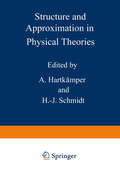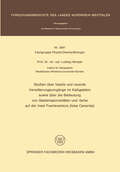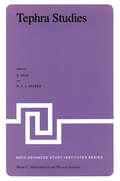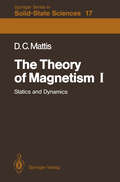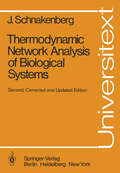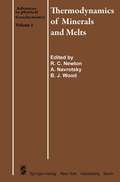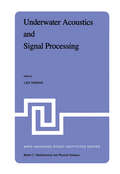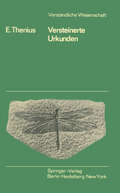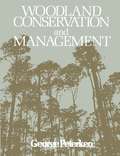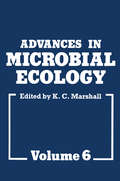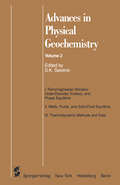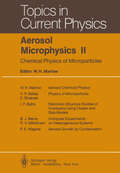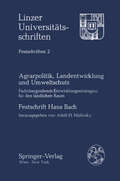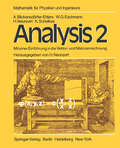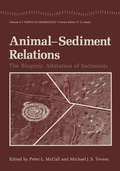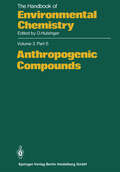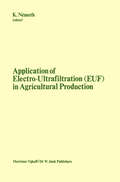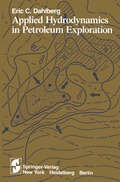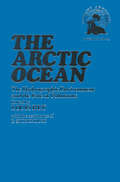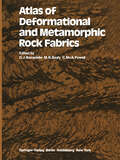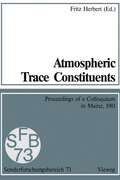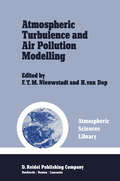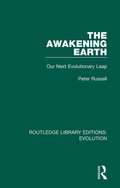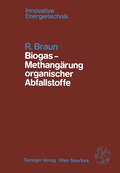- Table View
- List View
Structure and Approximation in Physical Theories
by A. HartkamperThe present volume contains 14 contributions presented at a colloquium on "Structure and Approximation in Physical Theories" held at Osnabruck in June 1980. The articles are presented in the revised form written after the colloquium and hence also take account of the results of the discussion at the colloquium. It is a striking feature that the problem of approximation in physical theories has only recently found some attention in the philosophy of science, although the working physicist is con stantly confronted with those questions. No interesting theory of exact science exactly fits its experimental data; almost every relation between different theories is an approximate one. There fore an adequate reconstruction of physical theories must take into account and conceptualize the moment of approximation. The majority of the articles in this book is centered around this subject. There are at least two elaborate, 'structuralistic' approaches to the formalization of physical theories in which the aspect of approximation has been incorporated: the approach due to P. Suppes, J. Sneed, W. Stegmuller ("S-approach") and the approach of G. Lud wig and his co-workers ("L-approach"). The articles in this book correspondingly fall into three classes: presentation, elaboration and critique of the L-approach [Hartkamper/Schmidt, Ludwig, Neumann, Werner, Schmidt, Mayr, Kamiah, Majer, Grafe] or of the S-approach [Moulines, Balzer, Cooke], and articles referring to both approaches or concerned with related matters [Scheibe, Pfarr, Castrigiano]. Of course, this is only a rough classification and each article must be appraised in its own right.
Studien über fossile und rezente Verwitterungsvorgänge im Kalkgestein sowie über die Bedeutung von Gesteinsporositäten und -farbe auf der Insel Fuerteventura (Forschungsberichte des Landes Nordrhein-Westfalen #3047)
by Ludwig HempelTephra Studies: Proceedings of the NATO Advanced Study Institute ”Tephra Studies as a Tool in Quaternary Research”, held in Laugarvatn and Reykjavík, Iceland, June 18–29, 1980 (Nato Science Series C: #75)
by St. Self R. S. SparksProceedings of the NATO Advanced Study Institute `Tephra Studies as a Tool in Quaternary Research', Laugarvatn and Reykjavik, Iceland, June 18-29, 1980
The Theory of Magnetism I: Statics and Dynamics (Springer Series in Solid-State Sciences #17)
by Daniel C. MattisStarting with a historical introduction to the study of magnetism - one of the oldest sciences known to man - before considering the most modern theories and observations (magnetic bubbles and soap films, effects of magnetic impurities in metals and spin glasses), this book develops the concepts and the mathematical expertise necessary to understand contemporary research in this field. Magnetic systems are important in technology and applied science, but they are also prototypes of more complex mathematical structures of great importance to theoretical physics. These connections are made repeatedly in this volume. After development of the necessary quantum theory of angular momentum and of interacting electron systems, a number of models which have been successful in the interpretation of experimental results are introduced: the Ising model, the Heisenberg model, the Stoner theory, the Kondo phenomenon, and so on. In the second edition the thorough approach and the main features which made the first edition a popular text have been retained. All important theories are worked out in detail using methods and notation that are uniform throughout. Footnotes and an extensive bibliography provide a guide to the original literature. A number of problems test the reader's skill.
Thermodynamic Network Analysis of Biological Systems (Universitext)
by J. SchnakenbergThe first edition of this book was greeted with broad interest from readers en gaged in various disciplines of biophysics. I received many stimulating and en couraging responses, however, some of the book's reviewers wanted to stress the fact that an extensive literature of network theory was not included or reported in the book. But the main aspect of the book is intended to be substantive rather than methodical: networks simply serve as a remedy for doing some first steps in analysing and modelling complex biological systems. For an advanced stage in the investigation of a particular system it may be appropriate to replace the pheno menological network method by more detailed techniques like statistical equations or computer simulations. According to this intention, the second edition of the book has been enlarged by further biological examples for network analysis, not by more network theory. There is a completely new section on a network model for photoreception. For this section I am obliged to J. Tiedge who did most of the detailed calculation and to my colleague Professor Stieve with whom we have had a very fruitful cooperation. Also I would like to mention that this work has been sponsored by the "Deutsche Forschungsgemei nschaft" i n the "Sonderforschungsberei ch 160". Recent results for excitable systems represented by feedback networks have also been included in the second edition, especially for limit cycle networks.
Thermodynamics of Minerals and Melts (Advances in Physical Geochemistry #1)
by R. C. Newton, A. Navrotsky and B. J. WoodToday large numbers of geoscientists apply thermodynamic theory to solu tions of a variety of problems in earth and planetary sciences. For most problems in chemistry, the application of thermodynamics is direct and rewarding. Geoscientists, however, deal with complex inorganic and organic substances. The complexities in the nature of mineralogical substances arise due to their involved crystal structure and multicomponental character. As a result, thermochemical solutions of many geological-planetological problems should be attempted only with a clear understanding of the crystal-chemical and thermochemical character of each mineral. The subject of physical geochemistry deals with the elucidation and application of physico-chemical principles to geosciences. Thermodynamics of mineral phases and crystalline solutions form an integral part of it. Developments in mineralogic thermody namics in recent years have been very encouraging, but do not easily reach many geoscientists interested mainly in applications. This series is to provide geoscientists and planetary scientists with current information on the develop ments in thermodynamics of mineral systems, and also provide the active researcher in this rapidly developing field with a forum through which he can popularize the important conclusions of his work. In the first several volumes, we plan to publish original contributions (with an abundant supply of back ground material for the uninitiated reader) and thoughtful reviews from a number of researchers on mineralogic thermodynamics, on the application of thermochemistry to planetary phase equilibria (including meteorites), and on kinetics of geochemical reactions.
Underwater Acoustics and Signal Processing: Proceedings of the NATO Advanced Study Institute held at Kollekolle, Copenhagen, Denmark, August 18–29, 1980 (Nato Science Series C: #66)
by L. BjøøThe comprehensive research activity around the World in the fields of Underwater Acoustics and Signal Processing being strongly supported by new experimental technique and equipment and by the parallel fast developments in computer technology and solid state devices, which has led to a rapidly reducing cost of digital processing thus enabling more complex processing to be carried out economically, emphasize how necessary it is at intervals of a few years through a NATO Advanced Study Institute (NATO ASI) and guided by leading experts to study the conquests in the fields of Underwater Acoustics and Signal Processing. This need of study is moreover stressed by the interdisciplina rity of Underwater Acoustics and Signal Processing, where a strong impact from other branches of science, - Geophysics, Radioastronomy, Bioengineering, Telecommunication, Seismology, Space Research etc. - is taking place, which makes it an extre mely difficult task for scientists to follow-up the development in all its phases and to preserve the general view of its rapid ly increasing number of possibilities. The present Proceedings of the NATO ASI held in Copenhagen during August 1980 join the series of proceedings of NATO summer schools on Underwater Acoustics and Signal Processing held during the past 20 years. The equality and the fusion of the individual research fields of Underwater Acoustics and Signal Processing and the separate introduction of advanced research results from other scientific areas related to underwater acoustics such as transducers characterize the subject matter of this NATO ASI.
Versteinerte Urkunden: Die Paläontologie als Wissenschaft vom Leben in der Vorzeit (Verständliche Wissenschaft #81)
by E. TheniusWoodland Conservation and Management
by G. F. PeterkenProfessor John Harper, in his recent Population Biology of Plants (1977), made a comment and asked a question which effectively states the theme of this book. Noting that 'one of the consequences of the development of the theory of vegetational climax has been to guide the observer's mind forwards', i. e. that 'vegetation is interpreted asa stage on the way to something', he commented that 'it might be more healthy and scientifically more sound to look more often backwards and search for the explanation of the present in the past, to explain systems in relation to their history rather than their goal'. He went on to contrast the 'disaster theory' of plant succession, which holds that communities are a response to the effects of past disasters, with the 'climax theory', that they are stages in the approach to a climax state, and then asked 'do we account most completely for the characteristics of a population by a knowledge of its history or of its destiny?' Had this question been put to R. S. Adamson, E. J. Salisbury, A. G. Tansley or A. S. Watt, who are amongst the giants of the first forty years of woodland ecology in Britain, their answer would surely have been that understanding lies in a knowledge of destiny. Whilst not unaware of the historical facts of British woodlands, they were preoccupied with ideas of natural succession and climax, and tended to interpret their observations in these terms.
Advances in Microbial Ecology: Volume 6 (Advances in Microbial Ecology #6)
by K. C. MarshallThis volume of Advances in Microbial Ecology marks a change in the editor ship of the series. The Editorial Board wishes to take this opportunity to express its gratitude to Martin Alexander, the founding editor and editor of the first five volumes, for his enterprise in establishing the series and in ensuring that Advances has become an outstanding focal point for the identification of new developments in the rapidly expanding field of microbial ecology. With the publication of this volume, we welcome Howard Slater to the Editorial Board. The policies of the Editorial Board remain the same as before. Most con tributions to Advances in Microbial Ecology will be solicited by the Board. However, individuals are encouraged to submit outlines of unsolicited contri butions to the Board for consideration for inclusion in the series. Advances is designed to serve an international audience and to provide critical reviews on basic and applied aspects of microbial ecology. Contributions in the present volume are predominantly concerned with the ecology of aquatic microorganisms, but encompass a variety of approaches to this area. The exception is the chapter by J. W. Doran on the role of micro organisms in the cycling of selenium. G-Y. Rhee discusses the effects of envi ronmental factors on phytoplankton growth. The factors limiting the produc tivity of freshwater microbial ecosystems are considered by H. W. Paerl.
Advances in Physical Geochemistry: Systematics And Estimation (Advances in Physical Geochemistry #2)
by Surendra K. SaxenaThe second volume of this series consists of three parts. Part I focuses on the research on intracrystalline reactions. This work, which began nearly two decades ago, is critically reviewed by Ghose and Ganguly in Chapter 1. Besides the review, the authors include some of their previously unpublished work to demonstrate how future research could aid in obtaining data on thermodynamics of solid solutions and in understanding the cooling history of igneous and metamorphic rocks. The latter is also the theme adopted by Kretz in the second chapter, which examines the redistribution of Fe and Mg in coexisting silicates during cooling. Chapter 3 contains new data on Fe-Mg distribution in clinopyroxenes. Dal Negro and his co-authors have selected a series of clinopyroxenes from volcanic rocks and present site occupancy data on several clinopyroxenes of intermediate compositions. The data set has not been published before and is the first of its kind. Part II of this book begins with a chapter on melts by Gaskell, who explores the relationship between density and structure of silicate melts. This is followed by the synthesis of data generated in the U.S.S.R. by Shmulovich and his co-authors on fluids. Blencoe, Merkel and Seil present a thorough analysis of the phase equilibrium data on feldspars coexisting with fluids in the third chapter in this part.
Aerosol Microphysics II: Chemical Physics of Microparticles (Topics in Current Physics #29)
by H. P. Baltes I. P. Batra B. J. Berne W. H. Marlow R. V. Mikkilineni E. Simanek P. E. WagnerAerosols, which are gas-phase dispersions of particulate matter, draw upon and con tribute to multidisciplinary work in technology and the natural sciences. As has been true throughout the history of science with other fields of interest whose un derlying disciplinary structure was either unclear or insufficiently well developed to contribute effectively to those fields, "aerosol science" has. developed its own methods and lore somewhat sequestered from the main lines of contemporary physical thought. Indeed, this independent development is the essential step in which syste matic or phenomenological descriptions are evolved with validity of sufficient gen erality to suggest the potential for development of a physically rigorous and gen eralizable body of knowledge. At the same time, the field has stimulated many ques tions which, limited to its own resources, are hopelessly beyond explanation. As Kuhn pointed out in The Structure of Scientific Revolution [2nd enlarged edition (University of Chicago Press, Chicago 1970) Chapter II and Postscript-1969) this is a very common juncture in the development of a science. In brief, the transition from this earlier stage to the mature stage of the science involves a general re cognition and agreement of what the foundations of the field consist of. By this critical step, a field settles upon a common language which is well defined rather than the ambiguous, and often undefined descriptors prevalent at the earlier stage.
Agrarpolitik, Landentwicklung und Umweltschutz: Fachübergreifende Entwicklungsstrategien für den ländlichen Raum Festschrift Hans Bach zum 70. Geburtstag dargebracht von Freunden, Kollegen und Schülern (Linzer Universitätsschriften #2)
Dem Agrar- und Gesellschaftswissenschafter Hans Bach anlCiB lich seiner Emeritierung eine Festschrift zu widmen, war seinen Freunden und Schiilem gleichermaBen Anliegen und Verpflich tung. Anliegen, um Hans Bach ihre Verbundenheit zu doku mentieren; Verpflichtung, einen Wissenschafter zu ehren, der jahrzehntelang mutig Auffassungen vertrat, die sich gerade in allerjiingster Zeit unter dem Eindruck einer sich bedrohlich ver stCirkenden Umweltkrise als weise vorausschauend herauszu stellen beginnen. Als Herausgeber darf ich allen, die zum Gelingen dieses Sammel bandes beigetragen haben, sehr herzlich danken. Mein beson derer Dank gilt den A utoren der einzelnen BeitrCige, den Mitarbei tern der Abteilung Agrarpolitik, Landentwicklung und Umwelt schutz am Institut iiir Gesellschaftspolitik der Johannes Kepler UniversitCit Linz sowie Herm o. Univ. Prof. Dr. Richard Holzham mer, der sich um die Aufnahme der Festschrift in die Linzer Uni versitCitsschrifterueihe bemiihte. Ganz besonders hervorheben mochte ich jene Institutionen, die durch ForderungsbeitrCige die Drucklegung der Festschrift ermoglichten. Der Herausgeber Linz, im MCirz 1982 Inhaltsverzeichnis EINLEITUNG . . . . . . . . . . . . . . . . . . . . . . . . 11 1. A bschnitt DIE GANZHEITLICHE SCHAUWEISE AM BEISPIEL GEISTES WISSENSCHAFfLICHER DISZIPLINEN . . . . . . . . . . . 11 Walter Heinrich: Mensch und Mutter Erde. Utopische Anmerkungen zum geistigen Testament von Arnold J. Toynbee . . . . . . . . 19 J. Hanns Pichler: U oIntegrierte oder ganzheitliche Ui. ndliche Entwicklung als Strukturfrage einer entsprechungsgerechten Weltlandwi- schaft . . . . . . . . . . . . . . . . . . . . . . . . . . . 31 Evelyn Grobl: Normative Voraussetzungen politischer Praxis . . . . . . . 53 2. AbschnittAGRARGESCHICHTE UND AGRARSOZIOLOGIE ALS UNENTBEHRLICHE INFORMA TIONSQUELLEN FUR EINE INTEGRATIVE BETRACHTUNG VON AGRARWESEN UND LANDLICHEM RAUM . . . . . . . . . . . . . . . . . . . 69 Albert Hauser: Bauerliche Leitideen im Wandel der Geschichte . . . . . . 11 Ulrich Planck: Der landwirtschaftliche Familienbetrieb als soziales System. 91 9 3.
Analysis 2: Mit einer Einführung in die Vektor- und Matrizenrechnung Ein Lehr- und Arbeitsbuch (Mathematik für Physiker und Ingenieure)
by A. Blickensdörfer-Ehlers W.G. Eschmann H Neunzert K. SchelkesAnimal-Sediment Relations: The Biogenic Alteration of Sediments (Topics in Geobiology #100)
by Peter L. McCallAnthropogenic Compounds (The Handbook of Environmental Chemistry #3 / 3B)
by K. J. Bock K. A. Daum E. Merian L. W. Newland C. R. Pearson H. Stache M. ZanderEnvironmental Chemistry is a relatively young science. Interest in this subject, however, is growing very rapidly and, although no agreement has been reached as yet about the exact content and limits of this interdisciplinary discipline, there appears to be increasing interest in seeing environmental topics which are based on chemistry embodied in this subject. One of the first objectives of Environmental Chemistry must be the study of the environment and of natural chemical processes which occur in the environment. A major purpose of this series on Environmental Chemistry, therefore, is to present a reasonably uniform view of various aspects of the chemistry of the environment and chemical reactions occurring in the environment. The industrial activities of man have given a new dimension to Environmental Chemistry. We have now synthesized and described over five million chemical compounds and chemical industry produces about hundred and fifty million tons of synthetic chemicals annually. We ship billions of tons of oil per year and through mining operations and other geophysical modifications, large quantities of inorganic and organic materials are released from their natural deposits. Cities and metropolitan areas of up to 15 million inhabitants produce large quantities of waste in relatively small and confined areas. Much of the chemical products and waste products of modern society are released into the environment either during production, storage, transport, use or ultimate disposal. These released materials participate in natural cycles and reactions and frequently lead to interference and disturbance of natural systems.
Application of Electro-Ultrafiltration (EUF) in Agricultural Production: Proceedings of the First International Symposium on the Application of Electro-Ultrafiltration in Agricultural Production, organized by the Hungarian Ministry of Agriculture and the Central Research Institute for Chemistry of the Hungarian Academy of Sciences, Budapest, May 610, 1980
by K. NémethThe Symposium was organized by the Hungarian Ministry of Agriculture and the Central Research Institute for Chemistry of the Hungarian Academy of Sciences. This arduous task was coordinated by Dr. Varju to whom I wish to express my appreciation for his whole-hearted assistance. After the Symposium the participants had the opportunity to visit the vineyards and cellars of the 'Balatonboglar' state holding which proved of great interest. The First International EUF Symposium owes its success to the excellent cooperation between the Biintehof Agricultural Research Station and the Hungarian Ministry of Agriculture, including the Central Research Institute for Chemistry of the Hungarian Academy of Sciences. The objective of the Symposium was to present the first results and experience gained with the EUF procedure, so that the papers delivered are only a survey of the present-day state of knowledge. The bulk of the work of editing, including the selection of the articles, fell on Prof. Dr. van Diest, Wageningen, for whose valuable advice and untiring efforts I wish to record my special thanks. Some of the papers presented at the Symposium have already been published elsewhere and they will not appear in this issue.
Applied Hydrodynamics in Petroleum Exploration
by E. C. DahlbergIt has for some time been the author's opinion that the need exists for a complete, self-contained volume on hydrodynamics addressed to and written in an idiom for geologists and geophysicists actively engaged in the search for hydrocarbons. This book is offered as my attempt to satisfy this need. Explorationists traditionally concern themselves with four basic aspects of oil and gas occurrence, since these constitute the necessary con ditions enhancing the likelihood of subsurface hydrocarbon accumula tions. They are: Trap, Reservoir, Source, and the Fluids themselves. His torically, great attention has been paid to traps and reservoirs, and much pertinent literature on structure, stratigraphy and lithology is available. With respect to sources, an increasing body of literature is becoming avail able in the form of articles, books and research reports in the areas of geochemistry and mineralogy. It is to the largely ignored fourth aspect, the fluids, that this book is directed. In its formulation I have drawn from numerous sources: college physics texts ("hydrodynamics is one of the most difficult subjects in physics"), personal notes from a rigorous two-week course presented by M. K. Hub bert (who literally fathered the discipline), journal articles (some strong and others weak in their treatment of the subject), discussions with expe rienced exploration geologists (some of whom have successfully utilized these procedures and others who were not so sure), and experience gained as well as mistakes made in the course of my own personal oil and gas exploration activities.
Atlas of Deformational and Metamorphic Rock Fabrics
by G. J. Borradaile M. B. Bayly C. McA PowellIn May 1976 Lucian B. Platt organized a highly successful Penrose Confer ence on The Formation of Rock Cleavage at Bryn Mawr College in Penn sylvania, U. S. A. The meeting drew together about 70 specialists from both sides of the Atlantic and from Australasia, who contributed discussions on various aspects of rock cleavage and its formation. Even early in the meet ing it became clear to the participants that they lacked a common terminol ogy, that often the same technical word implied different things to different people and that observables and descriptors were loosely defined. In an at tempt to improve communication the present editors contacted about 190 workers after the conference with a view to compiling a set of photographs with captions to illustrate exactly what workers were talking about. As a re sult the compilation was published as a limited edition by an inexpensive offset process at the University of Tasmania. The success of that provisional edition of the Atlas of Rock Cleavage and the responses of the readers prompted us to make a more extensive collection of material, contact a wider range of workers and, with the support of Dr. Konrad Springer, to publish the present higher-quality reproduction of the contributors' plates.
Atmospheric Trace Constituents: Proceedings of the 5th Two-Annual Colloquium of the Sonderforschungsbereich 73 of the Universities Frankfurt and Mainz and the Max-Planck-Institut Mainz, Held in Mainz, Germany, on 1 July 1981
by Fritz HerbertThis colloquium on Atmospheric Trace Constituents held in Mainz on July 1, 1981, was a joint one-day meeting of all scientific working groups of the SFB-73. The purpose of this meeting was to provide a fairly intensive and comprehensive review of the SFB-73 research work during the last two years and to discuss the state and the problems as well as possible future developments of the various projects. According to the scientific program of the SFB, the meeting consisted of two separate sessions devoted to actual research problems of trace gases (session I) as well as aerosol particles (session II) in the atmospheric environment. As in previous years, each of the 14 partial projects presented its efforts at least by one research contribution. In nearly twenty papers and discussions, methods, results and the present state of art as well as particularly numerous open questions in the experimental and theoretical studies could be explained. The range of topics considered can be gauged from the contents of this publication. The proceedings contain almost all papers presented at the colloquium. These papers have been issued as quickly as possible. Most of the authors devoted considerable efforts to keep within tight time and space deadlines. It is a pleasure to acknowledge these efforts here. A few number of papers, however, could only be re· ceived with a considerable time extension and this unfortunately caused an editorial delay of several months.
Atmospheric Turbulence and Air Pollution Modelling: A Course held in The Hague, 21–25 September, 1981 (Atmospheric and Oceanographic Sciences Library #1)
by H. Dop F. T. M.NieuwstadtThe study of turbulence in the atmosphere has seen considerable progress in the last decade. To put it briefly: boundary-layer meteorology, the branch of atmospheric science that concentrates on turbulence in the lower atmosphere, has moved from the surface layer into the boundary layer itself. The progress has been made on all fronts: theoretical, numerical and observational. On the other hand, air pollution modeling has not seen such a rapid evolution. It has not benefited as much as it should have from the increasing knowledge in the field of atmospheric turbulence. Air pollution modeling is still in many ways based on observations and theories of the surface layer only. This book aims to bring the reader up to date on recent advances in boundary-layer meteorology and to pave the path for applications in air pollution dispersion problems. The text originates from the material presented during a short course on Atmospheric Turbulence and Air Pollution Modeling held in The Hague during September 1981. This course was sponsored and organized by the Royal Netherlands Meteorological Institute, xi xii PREFACE to which both editors are affiliated. The Netherlands Government Ministry of Health and Environmental Protection and the Council of Europe also gave support.
The Awakening Earth: Our Next Evolutionary Leap (Routledge Library Editions: Evolution #11)
by Peter RussellOriginally published in 1982 The Awakening Earth explores the idea of the Earth as a collective, self-regulatory living organism, and considers in this context, the function of the human race. The book provides an exploration of humanity’s potential and explores the possibility of mankind’s evolutionary future. Drawing on the work of physicists, psychologists, philosophers and mystics, the book argues that humanity is on the verge of another evolutionary leap and explores evolution in the context of spiritual growth, arguing that widespread inner awakenings could lead to a more analogous society, functioning as a single social super-organism, much in the way cells in a body function as a biological organism.
The Awakening Earth: Our Next Evolutionary Leap (Routledge Library Editions: Evolution #11)
by Peter RussellOriginally published in 1982 The Awakening Earth explores the idea of the Earth as a collective, self-regulatory living organism, and considers in this context, the function of the human race. The book provides an exploration of humanity’s potential and explores the possibility of mankind’s evolutionary future. Drawing on the work of physicists, psychologists, philosophers and mystics, the book argues that humanity is on the verge of another evolutionary leap and explores evolution in the context of spiritual growth, arguing that widespread inner awakenings could lead to a more analogous society, functioning as a single social super-organism, much in the way cells in a body function as a biological organism.
